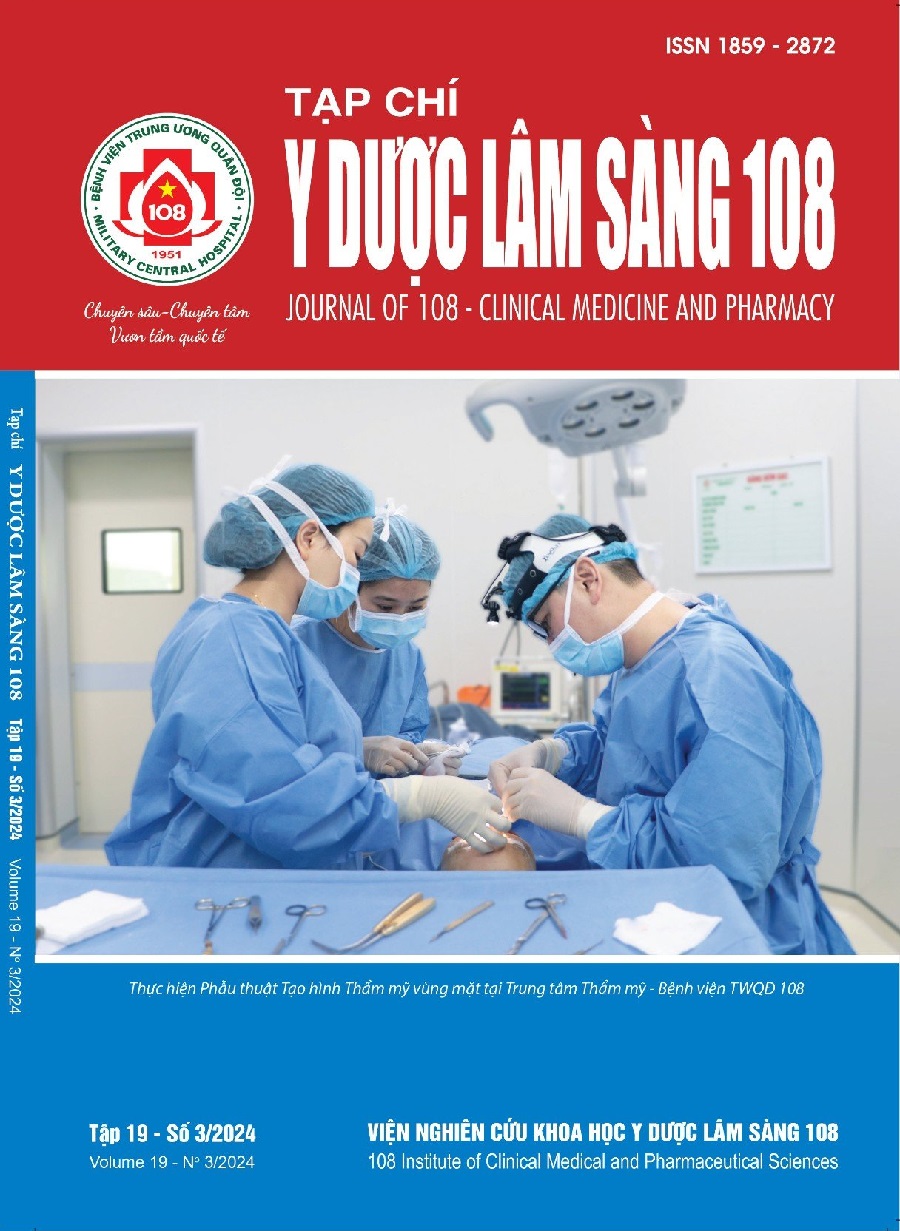Medium-term results of thoraci aortic aneurysm repair by endovascular intervention
Main Article Content
Keywords
Abstract
Objective: Evaluation of medium-term results of applying stent graft intervention technique to treat thoracic aortic aneurysms, with or without aortic arch cervical debranching. Subject and method: A retrospective descriptive study of thoracic aortic aneurysms patients treated by endovascular intervention at the Department of Cardiac Surgery, Cho Ray Hospital from August 2013 to October 2019. Result: In 80 patients, there were 62 males (78%), mean age 64.7 ± 11.6 (31-87 years old). Common risk factors were hypertension 61 (76%), smoking 51 (64%), dyslipidemia 49 (61%). Sacciform aneurysms 49 (61%), fuciform aneurysms 31 (39%). The average aneurysm diameter was 64 ± 15 (mm). The mean diameter of the arterial access was 7.23 ± 1.13 (mm). There were 43 cases of aortic arch cervical debranching before intervention (54%). The success rate of the intervention was 95%. Early mortality rate 3 (3.7%), no complications such as displacement, stenosis, fracture or twisting of the stent graft, aortic dissection, and cerebral artery occlusion. The mean follow-up time was 36.78 ± 17.27 months. Mid-term mortality rate 9 (11.7%). There were 5 cases of endoleak and 3 cases of stroke recorded during the mid-term follow-up period. 2 cases of reintervention, accounted for 2.6%. Conclusion: Treatment of thoracic aortic aneurysms by endovascular intervention, with or without aortic arch cervical debranching is safe and feasible with good early and medium-term results.
Article Details
References
2. Trần Quyết Tiến, Phan Quốc Hùng (2015) Can thiệp nội mạch điều trị phình động mạch chủ tại Bệnh viện Chợ Rẫy: Một số kết quả bước đầu. Y học Việt Nam, 1, tr. 39-44.
3. Nguyễn Lân Hiếu, Trần Vũ Hoàng (2013) Một số đặc điểm kỹ thuật và kết quả bước đầu của can thiệp đặt stent graft ở bệnh nhân có bệnh lý động mạch chủ tại Viện Tim mạch quốc gia. Y học thực hành 866 (04), tr. 171-173.
4. Raimund E, Victor A, Catherine B et al (2014) ESC Guidelines on the diagnosis and treatment of aortic diseases: document covering acute and chronic aortic diseases of the thoracic and abdominal aorta of the adult The Task Force for the Diagnosis and Treatment of Aortic Diseases of the European Society of Cardiology (ESC). J European heart journal 35(41): 2873-2926.
5. Mark FF, Roy KG, James FM et al (2010) Reporting standards for thoracic endovascular aortic repair (TEVAR). J Journal of vascular surgery 52(4): 1022-1033.
6. Shih-Wei W, Yaw-Bin H, Jiann-Woei H et al (2015) Epidemiology, clinical features, and prescribing patterns of aortic aneurysm in Asian population from 2005 to 2011. J Medicine 94(41): 1-6.
7. Rita F, Giuseppe G, Paolo C et al (2013) Endovascular treatment of thoracic aortic aneurysm: a single-center experience. J Annals of vascular surgery 27(8): 1020-1028.
8. Hyun-Chel J, Young-Nam Y, Young-Guk K et al (2018) Comparison of open surgical versus hybrid endovascular repair for descending thoracic aortic aneurysms with distal arch involvement. J Journal of thoracic disease 10(6): 3548-3557.
9. Shin-Ah S, Deok HL, Tak-Hyuk O et al (2019) Risk factors associated with reintervention after thoracic endovascular aortic repair for descending aortic pathologies. J Vascular endovascular surgery 53(3): 181-188.
 ISSN: 1859 - 2872
ISSN: 1859 - 2872
